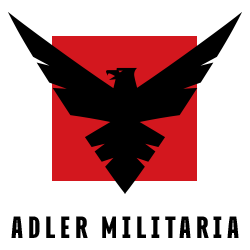Showing 280–288 of 1325 resultsSorted by latest
-
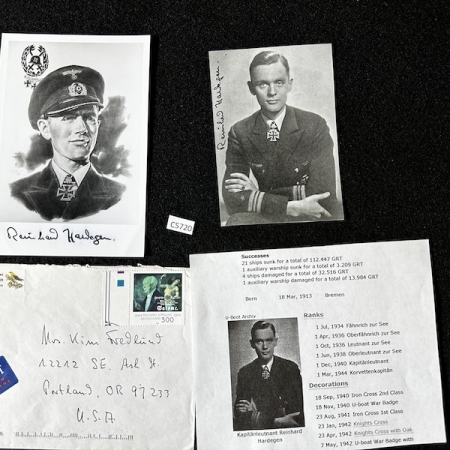
Post War – Correspondence U-Boat Commander Korvettenkapitän Reinhard Hardegen – Hand Signed Photos
$175.00Korvettenkapitän Reinhard Hardegen (18 March 1913 – 9 June 2018) was a German U-boat commander during World War II. He was credited with the sinking of 25 ships (2 were later refloated), at a total of 136,661 tons.[1] After the war, he spent a year and a half as a British prisoner-of-war before starting a successful oil trading business and serving as a member of Bremen’s city council (the Bürgerschaft) for over 32 years.
-

Post War Signed Luftwaffe Ace Horst Petzschler – Air Ace – F190 JG 52
Great history on this website of Horst: German, FW-190 Ace, Horst Petzschler
-
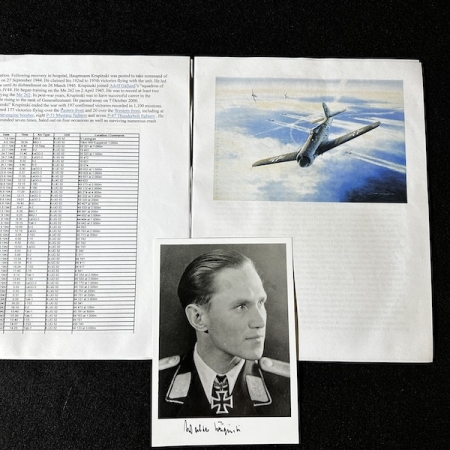
-

WWII German Propaganda for Soviet Soldiers – Large – Rare
$65.00An interesting bit of German propaganda used to encourge Soviet Soldiers to come over to the German lines. It is about the size of an A4 Page.
-
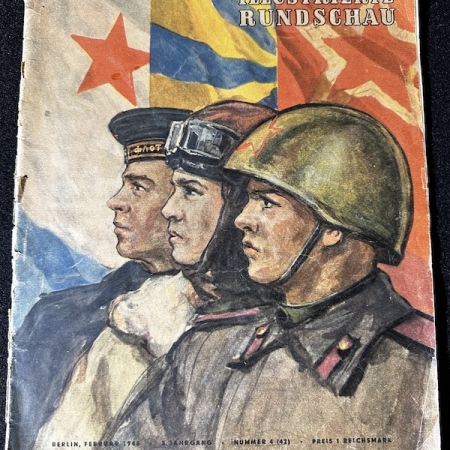
Soviet Occupation Army of Berlin Feb 1948 – Illustrierte Rundschau – Interesting Content Rare Magazine – Rare
Original Magazine Illustrierte Rundschau Feb 1948
-
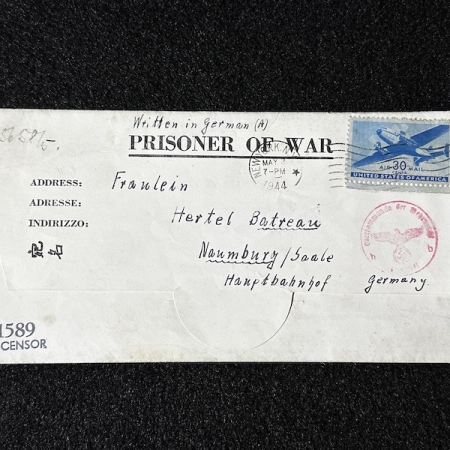
WWII German Army POW – Communist Willy Seigmeyer – Censored Political Prisoner in 999 Penal – Captured in Afrika Korps sent to USA – Colorado Springs Camp Carson – Rare
An incredible set of Feldpost here to the “Communist Willy Siegmeyer” Sent from Soldat Willy Seigmeyer Schutzen-Regiment 962 – Penal unit destroyed in Tunis with the German Africa Corps Regiment 962 and 961 were formed at the end of 1942 in Belgium as Disciplinary 999 Brigade and were based in the Antwerp Region. A so called “Bewahrungseinheit” or “Strafbattalion” were German soldiers who had done some kind of failure ( Theft’s, almost Deserter’s, or so called “Cowards in the front of the Enemy”, and so on. Being in this unit was the only chance of Rehabilitation, it’s debated as to whether this unit was a penal unit, dispite this assumption the ordinary ranks were not permitted to wear the National Eagle, collar patches or cockade on their uniforms, nor were they allowed to wear the traditional army belt with the National Eagle displayed on them. In March 1943 the unit had reached up to Division size and became 999 Division, at the same time 961 and 962 rifle Regiments ( MOT ) were sent to North Afrika and were redesignated as the 999th Leichte Afrika Division. Actual units in N.Afrika were. Willy Siegmeyer is mentioned here: Naumburger in opposition and resistance against National Socialism “Geboren am 25. März 1911, Kellner, Schreberstraße 15, 9 Monate 1933/1934 inhaftiert, 1942 Strafbataillon 999, verstorben am 21. November 1977.” “Born on March 25, 1911, Kellner, Schreberstrasse 15, imprisoned for 9 months in 1933/1934, 1942 Penal Battalion 999, died on November 21, 1977.” https://www.naumburg-geschichte.de/geschichte/uebersichtwiderstand.htm ( Collected before – Collection of Walter Grunert, Naumburg ) The grouping consists of: Letter sent from 48398 E – Schutzen-Regiment 962 – 25.2.1943 – Sent from Africa to Hertel from Soldat W. Seigmeyer POW Letter Sent – 2nd of May 1944 -7.PM New York City, USA – US Airmail Stamp – to Hertel Batreau – Censored By US Censor 11589 – Arrived in Germany – Censored by German High Command – Inside – Water/Ink Censor – Sent from POW Camp Carson USA. Collectors Remarks – Short synopsis in German language – Post from the communist Willy Siegmeyer, after years in prison he was sent to the Front with Penal Unit 999. In Africa, he made it to US lines as a POW. Letter from his time as a POW on 2nd of May 1944. More on Camp Carson Fort Carson was established in 1942 as Camp Carson in the months after the US entry into World War II. It was named after a frontiersman, trapper, Indian fighter, and general, “Kit” Carson. During WWII, Fort Carson was a training center for about 125 units, most famously the 10th Mountain Division. Carson also trained all sorts of other personnel, including cooks, nurses, tank battalions, and Greek infantry and Italian ordnance units. Fort Carson, just south of Colorado Springs, made an ideal location for training mountain units for deployment to the European Alps or other mountainous areas. The demands of such terrain required Fort Carson to maintain the last mule trains in the US Army. From Fort opening to 1956, mule teams packed gear for Army mountain units; the senior mule, Hambone, served as mount for First Sergeants for thirteen years, survived until 1971, and was buried with full military honors. On the first day of 1943, Camp Carson opened a POW camp for about 9,000 German, Italian prisoners. The POWs worked to relieve a manpower shortage in Colorado, farming and canning and generally providing labor, for a low but real wage. Camp Carson became a fort in 1954, expanded its base land considerably in the 1950s and 1960s, and became home to armor units; today Fort Carson is home to the 10th Special Forces Group, 4th Infantry Division, and a large and varied collection of other and tenant units. https://www.fortcarsonhousing.com/history Final Comments: There are not many stories like this and makes for a prime research project first source material.
-

Cold War Begin – 1948 Berlin Airlift – Operation Vittles Movie – NBC / ABC Reporter Nancy Craig – Berlin Interview with Berliner Dr Rainer Hildebrandt – Check Point Charlie Museum Founder – Bad Treatment East Germany 1949 – Woman of Tomorrow – Coast to Coast Radio Show – Radio Geneve – US Airforce – Tempelhof Berlin 1948 – Rare
Really interesting lot here, Nancy Craig was a reporter for NBC, it seemed she interviewed Dr R. Hildebrandt Rainer Hildebrandt, son of the art historian Hans Hildebrandt and the painter Lily Hildebrandt, studied physics in Berlin, later philosophy and sociology at the Faculty of Foreign Studies, and earned his doctorate under Franz Rupp on a topic in psychology.[1] At his university, a lively circle of resistant lecturers and students gathered from 1939/40 on. Among them were Harro Schulze-Boysen and Horst Heilmann as well as the professor Albrecht Haushofer and the student Rainer Hildebrandt. He had contact with the wider circle of the July 20, 1944, conspirators and was a member of the Haushofer circle: “A long look goes out to the companions. I lost my best friends, Albrecht Haushofer and Horst Heilmann, in the Nazi Reich and was myself imprisoned for 17 months. I learned to fight against injustice.” Hildebrandt was imprisoned for “Wehrkraftzersetzung” and connections to resistance groups. After the beginning of the Cold War, Hildebrandt, together with the writer Günther Birkenfeld, the then chairman of the Junge Union Ernst Benda and the then FDP city councilor Herbert Geisler, founded the anti-communist Kampfgruppe gegen Unmenschlichkeit (KgU), which was financed by secret services, as a licensee of the Allied Command. At the beginning, this Kampfgruppe was headed by Rainer Hildebrandt, whose main goal was initially to set up a tracing service to track down the many arrested and disappeared or abducted and missing and deceased persons in the Soviet occupation zone. Other files existed in parallel, such as one of denunciators who had imprisoned fellow citizens or those that provided information on the political, economic and military situation. According to his own account, there were three kidnapping attempts against Hildebrandt, including by the GDR State Security. According to Hildebrandt’s recollections, the first kidnapping attempt failed on July 24, 1949. After his retirement from the KgU, Hildebrandt devoted most of his time to public relations work and then to the Arbeitsgemeinschaft 13. August, which was founded shortly after the construction of the Berlin Wall. Until the end, Hildebrandt directed the Checkpoint Charlie Museum. On October 1, 1992, Hildebrandt was awarded the Order of Merit of the State of Berlin, and in 1994 Roman Herzog awarded him the Federal Cross of Merit I Class. In 1995 Hildebrandt married Alexandra Hildebrandt. On January 9, 2004, Rainer Hildebrandt died at the age of 89. In 2004, the International Human Rights Award Dr.-Rainer-Hildebrandt-Medaille was established. It is awarded annually since 2005 to individuals who have campaigned for human rights in a non-violent manner. The jury includes Henry Kissinger, Avi Primor, Joachim Gauck, Hans-Dietrich Genscher, and Sergei Khrushchev. https://en.wikipedia.org/wiki/Rainer_Hildebrandt Here is the Op Vittles information and video clip. https://www.c-span.org/video/?464908-1/operation-vittles
-

WWII US Army Medal Lot – Mike Paul Benz – Bronze Star Named – Early Serial Numbered Purple Heart – Wounded by MG Fire September 1944 France
I was able to find some details on the owner. It seems his father was from Czechoslovakia and immigrated to the USA. Name: Mike P Benz Birth Date 27 Apr 1922 Death Date 25 Jun 1993 Cause of Death Natural SSN 285127284 Enlistment Branch ARMY Enlistment Date 18 Dec 1942 Discharge Date 30 Nov 1945 Wounded Name Mike P Benz Race White, includes Mexican (White) Rank Enlisted Man Admission Age 22 Birth Date abt 1922 Admission Date Sep 1944 Discharge Date Dec 1944 Military Branch Infantry, General or Unspecified Diagnosis FirstLocation: Metacarpal bones and Phalanges: Phalanges, generally; CausativeAgent: Bullet, Machine Gun Type of Injury Casualty, battle Medical Treatment Fracture, compound, closed, treatment of, with splints or casts Injured in Line of Duty In line of duty Type of Discharge Duty Length of Service 1 Year(s), 9, 10 OR 11 MONTHS Month(s) Sadly I was unable to locate any record for the Bronze Star, it is likely the wounding took place in France in September of 1944.
-

WWII US Army Uniform – 4th Armoured Combat Medic – Tunic – Trousers – Side Cap – Laundry Number – France 1944 / Ardennes 1944
$400.00We were not able to completely confirm the owner of this uniform, it came as one set to us and has period applied insignia and a faint laundry number. Deserves further research. The 4th Armoured Division The division was organized as a full Armored Division in May and June 1942 under the command of Major General John Shirley Wood. It left Pine Camp for Camp Forrest for the Tennessee maneuvers in the Cumberland Mountains held in September and October. In mid-November, it was transferred to the Camp Ibis Desert Training Center (DTC) in the California-Arizona maneuver area and was the first Armored Division to occupy Camp Ibis near Needles, California in the Mojave Desert, which was close to the Arizona and Nevada borders. On 3 June, the 4th AD arrived at Camp Bowie, Texas, an armored training center located in central Texas near Brownwood, for more maneuvers until about December when it departed for Camp Myles Standish in Massachusetts for winter training. On 29 December, the 4th AD departed Boston to conduct training in England in preparation for the invasion of Normandy. France After training in England from January to July 1944, the 4th Armored Division landed at Utah Beach, on 11 July, over a month after the initial Normandy landings, and first entered combat on 17 July; on 28 July, battle action as part of the VIII Corps exploitation force for Operation Cobra, the 4th AD secured the Coutances area. The 4th AD then swung south to take Nantes, cutting off the Brittany Peninsula, 12 August 1944. Turning east, it drove swiftly across France north of the Loire, smashed across the Moselle 11–13 September, flanked Nancy and captured Lunéville, 16 September. The 4th AD fought several German panzergrenadier brigades in the Lorraine area including the SS Panzergrenadier Brigade 49 and SS Panzergrenadier Brigade 51 at this time, defeating a larger German force through superior tactics and training. After maintaining a defensive line, Chambrey to Xanrey to Hénaménil, from 27 September to 11 October, the 4th AD rested briefly before returning to combat 9 November with an attack in the vicinity of Viviers. The 4th AD cleared Bois de Serres, 12 November, advanced through Dieuze and crossed the Saar River, 21–22 November, to establish and expand bridgehead and took Singling and Bining, then Baerendorf 24 November, before being relieved 8 December. The 4th Armored Division received the following unit awards from France: Croix de Guerre with Palm (27–29 July 1944), Croix de Guerre with Palm (12–29 September 1944), and French Fourragere in the colors of the Croix de Guerre. Battle of the Bulge Two days after the Germans launched their Ardennes Offensive, the 4th AD entered the fight (18 December 1944), racing northwest into Belgium, covering 150 miles in 19 hours. The 4th AD, spearheading Patton’s Third Army, attacked the Germans at Bastogne and, on 26 December, was the first unit (Company C, 37th Tank Battalion led the 4th Armored Division column that relieved Bastogne during the Battle of the Bulge)[8] to break through at Bastogne and relieve the besieged 101st Airborne Division. Six weeks later the 4th AD jumped off from Luxembourg City in an eastward plunge that carried it across the Moselle River at Trier, south, and east to Worms, and across the Rhine, 24–25 March 1945. Advancing all night, the 4th AD crossed the Main River the next day, south of Hanau, and continued to push on. Lauterbach fell 29 March, Creuzburg across the Werra on 1 April, Gotha on 4 April – where the 4th AD liberated Ohrdruf concentration camp, the first Nazi camp liberated by U.S. troops.[9] By 12 April the 4th AD was across the Saale River. Pursuit of the enemy continued, and by 6 May the division had crossed into Czechoslovakia and established a bridgehead across the Otava River at Strakonice, with forwarding elements at Písek. The 4th AD was reassigned to the XII Corps on 30 April 1945. The 4th AD received the following Letter of Commendation: To: Maj. Gen. Hugh J. Gaffey The outstanding celerity of your movement and the unremitting, vicious and skillful manner in which you pushed the attack, terminating at the end of four days and nights of incessant battle in the relief of Bastogne, constitutes one of the finest chapters in the glorious history of the United States Army. You and the officers and men of your command are hereby commended for a superior performance. Lt. Gen. George S. Patton, Jr., Commander, Third U.S. Army The 4th AD’s second commander, Major General John Shirley Wood, (known as “P” Wood to his contemporaries, the “P” standing for “Professor”, and “Tiger Jack” to his men) who took over the division officially on 18 June 1942, trained the 4th Armored Division for two years before he personally led it into combat in France, on 28 July 1944, and was awarded the Distinguished Service Cross. On 1 August, Gen. George Patton’s U.S. Third Army became operational and the 4th AD became the spearhead of the Third Army. The British military armor theorist and historian, Capt. Basil Henry Liddell Hart, once referred to General Wood as “the Rommel of the American armored forces.” Like Rommel, Wood commanded from the front, and preferred staying on the offensive, using speed and envelopment tactics to confuse the enemy. General Wood often utilized a light Piper Cub liaison aircraft flown by his personal pilot, Maj. Charles “Bazooka Charlie” Carpenter, to keep up with his rapidly moving division, sometimes personally carrying corps orders from headquarters directly to his advancing armored columns. On 3 December 1944, General Wood was relieved as division commander. The division was then led by Major General Hugh Gaffey through the Battle of the Bulge until March 23, when Brigadier General William M. Hoge was awarded command. Major General Fay B. Prickett commanded during the occupation period. Major General Archibald R. Kennedy commanded the division after the war. Among the most famous members of the 4th AD during World War II was…
